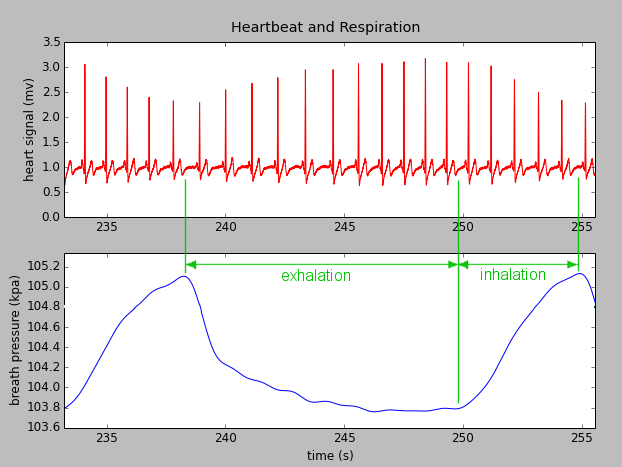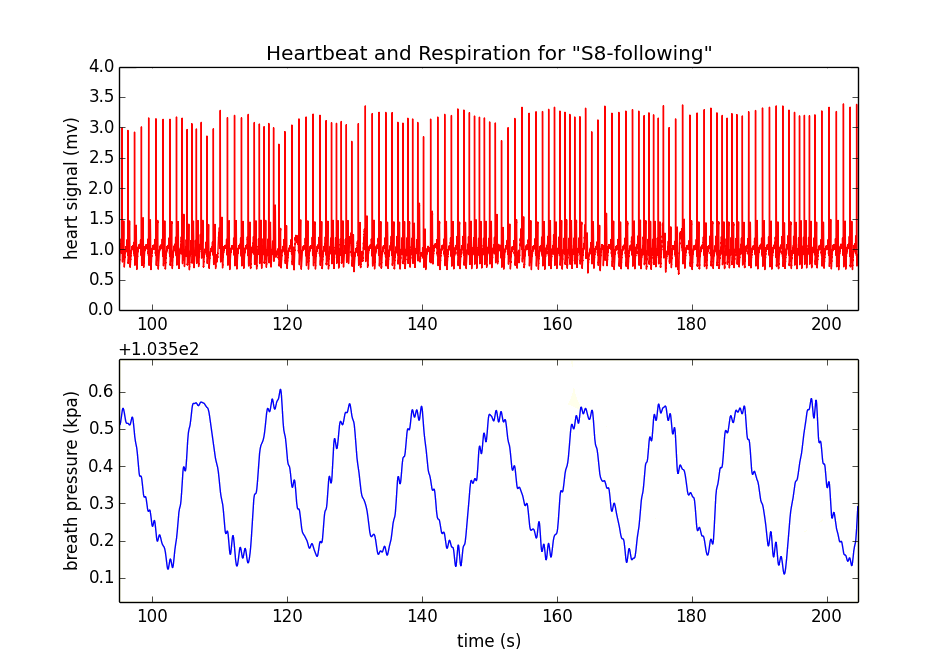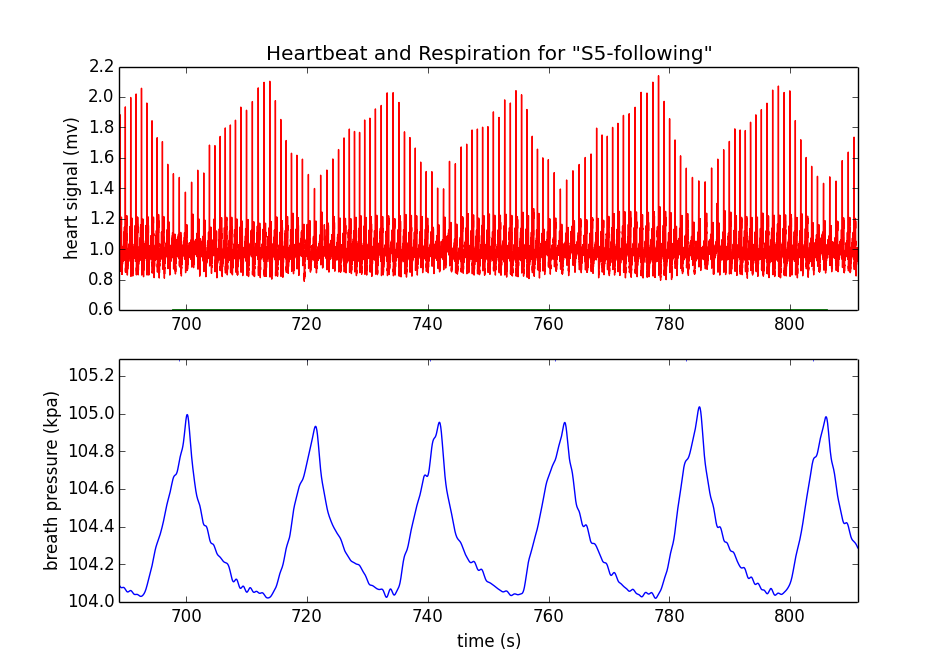The plots below show electrocardiogram and respiration signals for a 20-second segment of meditation.

Heartbeat and Respiration during meditation. Note the increase in amplitude of the ECG signal during exhalations.
During exhalations, the amplitude of the waves in the upper plot (the sharp spikes in the electrocardiogram, known as R-waves) increase while they decrease during inhalations.
A comparison of ECG signals for a novice and an experienced meditator are shown below.

Heartbeat and respiration for Subject 8, a relatively inexperienced meditator. Amplitude of R-wave increases by ~10% during exhalations.

Heartbeat and respiration for a highly trained meditator. Amplitude of R-wave increases by ~50% during exhalations.
For novice meditators, this effect was small (roughly 10% change in R-wave amplitude, as shown in the upper figure, above). For highly trained meditators the effect was quite pronounced (roughly 50% as shown in the lower figure, above).
The amplitude of the R-wave is an indicator of the strength of the signal from the heart when the left ventricle is forcing blood out to the rest of the body. The electrical resistance of the body between the heart and the ECG electrode on the surface of the skin changes as the lungs fill with air and then collapse. After consulting with a cardiorespiratory expert (an anesthesiologist), I have concluded that this dramatic change in R-wave magnitude reflects the deeper breathing of the trained meditator—as the intrathoracic cavity collapses during exhalation, the gap between the heart and the outer surface of the body (where the ECG signal is measured) shrinks, thereby reducing electrical resistance and resulting in an increased amplitude of the R-wave.
interesting work. you found an effect of meditation expertise on R wave amplitude modulation by breath, but concluded in the end (rightly so i would guess) that it was probably just because meditators took deeper breaths. did you try to control for breath depth at all?
other questions:
1) your two y axis plots for breath pressure are very different scales in your two subjects. why?
2) it seemed like your original interest (from the snippet at your main page that got me here) was on how breath sync with heart effects meditation. there you said ” The synchronized rhythm felt pleasurable—having both the heart and lungs involved seemed to help me to maintain a clear mind.” i’d love to hear more about this. do you continue to try to synchronize in your practice? what did other experienced meditators think? in the vipassana tradition they seek to minimize any modulation of bodily function in favor of being with “what is”. i have been moving away from this in my practice because i think modulation of physiiology can accelerate recalibration of mind. its important to use the tools we have!
Great observations! I love it when people read things thoughtfully.
Two things struck me in this small sample: (1) Regardless of what meditation tradition people had trained in, their breathing during ‘meditation’ was always deeper and slower than when, say, reading. (2) Very experienced Zen practitioners displayed considerably deeper and slower breathing than novices. There weren’t enough subjects to try to control for breath depth, anyway.
Regarding the scales on the breath pressure graphs, the scales are actually not as different as they look. The graphing package, matplotlib automatically put ‘+1.035e2’ above the y-axis of the breath pressure axis of the novice, so the range actually is from 103.5 to 104.1 kpa (weird, I grant you). These pressures depend on how tightly the cuff is fastened around the chest, so it can vary considerably from one subject to another.
I have not continued the heart/breath synchronization practice on a daily basis, but occasionally I use it during a sesshin. When I asked my teacher, Shodo Harada about this, we had this exchange (http://onedropzen.org/teachings/questions_and_answers?tag=zazen):
Could you comment on synchronizing the breath with the pulse? During Golden Hour I practiced counting my breaths continuously while keeping an awareness of my beating heart. Each exhalation occurred during 8 heartbeats and each inhalation over 4 heartbeats. It felt very soothing like rocking a baby.
September 26, 2014, 3:48 pm
To match the breathing to the heartbeat should be fine during zazen when you are not moving, but when you are walking, when you run, when you work and use your body, the heartbeat will change. Then can you still count your heartbeats? At that point the counting will become an obstruction to deepening your samadhi.
Are the R-wave amplitude drops correlated with the drops in BPM? We’re making a wearable HRV device that works on similar principles!
Rohan,
I was definitely seeing an increase in R-wave amplitude with an increase in the volume of air in the exhalation. Since a deeper breath generally goes with a slower breath, I would expect a correlation between R-wave amplitude and the period of the breath cycle.
I’ve seen research articles on heart rate variability (HRV) and meditation, but I haven’t actually computed HRV in ECG signals. I would like to know more about the HRV device you describe.
We can say that to train deep breath is the key to reduce the brain waves patterns?
Thiago,
I’ve found it valuable to practice expelling all the air during each exhalation and letting the in-breath happen effortlessly. It’s a practical way of letting go of mental concerns and obsessions.
I observed my meditations and discovered that the heartbeat lub-dub and breath in-out sync after 20 minutes. I search on web and found your web addressed this sync. Thanks a lot.
Sam
Sam, thank you for reporting your observation of heartbeat syncing with breath. In my usual daily practice, I rarely observe this, but by the third or fourth day of a meditation retreat I generally have settled down enough to be simultaneously conscious of heart rhythm and breath–it’s at those times that they synchronize.